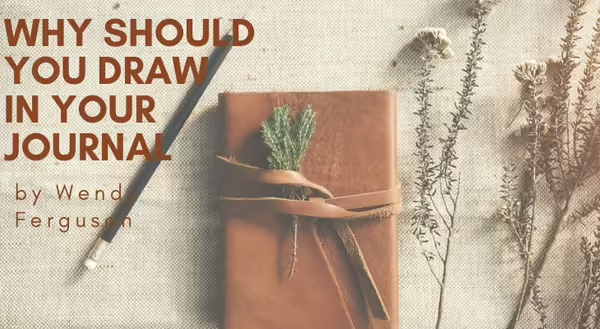
Are you sketching in your journal? If not, maybe you should be. I know, you are thinking to yourself, “But I can’t draw.” Or “I can’t even do a stick figure.” Am I right? Whether you are good or bad at sketching is beside the point. The important part is the act of drawing, itself.
Drawing is good for you. It is exercise for the eyes, hands, and mind and it can be a form of visual thinking, an outlet for emotions, and a record of a moment in time.
The act of drawing slows you down. When you draw, you take the time to really look at something, to analyze it and reproduce it. You’re not simply taking a photo and moving on to the next image. You become very aware of form, proportion, and color. You come to understand light and shadow and how they reveal and define form. This awareness translates into other areas of life as well.
Through drawing, we better understand our subject matter. This understanding can take many forms. It can be a better grasp of an object’s form, or how we feel and respond to whatever the subject matter is. The more you draw something, the more you remember it and know it. When we draw, we see the things we’d otherwise overlook.
If that were not enough, it also improves your overall emotional mood. In a study in Psychology of Aesthetics, Creativity, and the Arts, researchers found that drawing to distract even for one session improved mood (based on testing and life satisfaction scale). The improvement persisted over several days. Sounds like a good reason to draw, right?
So how do you begin?
1. Go draw something. Repeat.
Practice leads to improvement. You won’t get any better unless you engage in the attempt. The more you draw the more confident you’ll become.
2. Draw from drawings.
This may sound peculiar, but try copying a Da Vinci or Michelangelo sketch. Learn from them. Really. They won’t mind. This is what I did as a child and it taught me a lot about line, shading and underlying structure. This is what their apprentices did as well to learn their trade.
3. Draw from life.
If you’re just starting out, pick simple objects and work your way up to complex ones. Drink coffee? Start with a coffee cup. Want to draw something from nature? Winter is an excellent time to study and draw the structure of trees. It is much easier during this time of year to see how the branches grow out of the trunk, what general shape they form and more. Pick up a stick from the ground and bring it inside to really study it and sketch it. Claire Walker Leslie’s, Nature Drawing contains tips and techniques for drawing trees and numerous examples of fine tree drawings by her favorite artists which she too, suggests copying.
For me, drawing is foundational to who I am, but it’s also something that provides a lot of pleasure and relaxation. I simply enjoy drawing. I find that drawing something or someone makes that thing or person more important to me. As I come to understand the object as I draw it, I can perceive how it was formed and why. That leads to greater perceptions altogether.
For those who tell me that they can’t draw a straight line, I can’t either. I use a ruler for that.
Quick tip: Try turning a familiar object upside down to draw it. This will confuse the logical, naming part of your brain and allow for the visual, instinctive part of your brain to take the lead. This will help in actually drawing what you are seeing rather than drawing what your brain tells you it should look like.